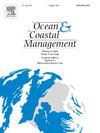Synergistic effects of elevation loss and environmental extremes trigger salt marsh die-off in the Yangtze Estuary
IF 5.4
2区 环境科学与生态学
Q1 OCEANOGRAPHY
引用次数: 0
Abstract
Complex extreme events increasingly threaten coastal ecosystems, yet quantitative understanding of critical thresholds remains limited. Using a five-year dataset (2019–2023) that captured an unprecedented vegetation die-off in the Yangtze Estuary, we quantitatively derive ecological thresholds through GAM analysis. Our results establish critical thresholds of approximately 34.1 °C for temperature and 19.77 PSU for salinity; vegetation die-off arises when both thresholds are exceeded simultaneously. River discharge emerges as a critical regulatory variable that determines vegetation sensitivity to temperature-salinity extremes, with a strong negative correlation (r = -0.77, p = 0.014) between discharge and high salinity events. Low discharge conditions (<800 × 108 m3/month) increase high salinity exposure seven-fold compared to high discharge periods. Our analysis reveals that the interaction between press (elevation loss) and pulse (environmental extremes) disturbances contributes 47.5 % of vegetation response variance, far exceeding their individual effects. These results illuminate how “press” disturbances (elevation loss from reduced sediment) increase susceptibility to “pulse” events (extreme temperature, salinity, and reduced discharge). The identified thresholds provide quantitative targets for early warning systems, suggesting dual management approaches targeting both press and pulse disturbances. These findings offer a transferable framework for predicting ecological transitions in river-dominated estuaries worldwide, enhancing coastal wetland management under intensifying climate extremes.
高程下降和极端环境的协同作用导致长江口盐沼消亡
复杂的极端事件日益威胁沿海生态系统,但对临界阈值的定量理解仍然有限。利用长江口5年(2019-2023)植被死亡数据,通过GAM分析定量导出了生态阈值。我们的结果建立了临界阈值,温度约为34.1°C,盐度约为19.77 PSU;当两个阈值同时被超过时,就会出现植被死亡。河流流量是决定植被对极端温度-盐度敏感性的关键调节变量,流量与高盐度事件之间存在很强的负相关(r = -0.77, p = 0.014)。低排放条件(<;800 × 108 m3/月)比高排放时期增加了7倍的高盐度暴露。我们的分析表明,压力(海拔损失)和脉冲(极端环境)扰动之间的相互作用贡献了47.5%的植被响应方差,远远超过了它们的单独影响。这些结果阐明了“压力”扰动(沉积物减少造成的海拔损失)如何增加对“脉冲”事件(极端温度、盐度和流量减少)的敏感性。所确定的阈值为预警系统提供了定量目标,提出了针对压力和脉冲干扰的双重管理方法。这些发现为预测世界范围内河流主导的河口生态转变提供了一个可转移的框架,加强了极端气候加剧下的沿海湿地管理。
本文章由计算机程序翻译,如有差异,请以英文原文为准。
求助全文
约1分钟内获得全文
求助全文
来源期刊

Ocean & Coastal Management
环境科学-海洋学
CiteScore
8.50
自引率
15.20%
发文量
321
审稿时长
60 days
期刊介绍:
Ocean & Coastal Management is the leading international journal dedicated to the study of all aspects of ocean and coastal management from the global to local levels.
We publish rigorously peer-reviewed manuscripts from all disciplines, and inter-/trans-disciplinary and co-designed research, but all submissions must make clear the relevance to management and/or governance issues relevant to the sustainable development and conservation of oceans and coasts.
Comparative studies (from sub-national to trans-national cases, and other management / policy arenas) are encouraged, as are studies that critically assess current management practices and governance approaches. Submissions involving robust analysis, development of theory, and improvement of management practice are especially welcome.
 求助内容:
求助内容: 应助结果提醒方式:
应助结果提醒方式:


